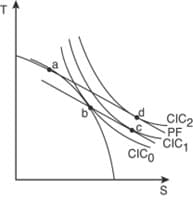1. This country has a comparative advantage in a. Sb. Tc. both S and T d. need more information to determine 2. The production point with free trade is a point a b. point b c. point cd. point d 3. If point b is the autarky production, then the movement from point b to point c represents a. the static production gains from trade. b. total gains from free trade. c. the static consumption gains from trade. d. none of the above. 4. If point b is the autarky production, then the movement from point c to point d represents a. the static production gains from trade. b. the dynamic gains from trade. c. the static consumption gains from trade. d. tariff revenue. 5. When the community indifference curves are used as indicators of community welfare, the movement from CICO to CIC2 illustrates a. the one - time gains from the shift from autarky to trading at world prices. b. the total static gains from trade. c. an improvement in welfare. d. all of the above. 6. Dynamic gains from trade refer to a. the change in resource allocation as producers move from point b to point a. b. the natural increase in the supply of labor. c. the relationship between trade and increased economic growth.1. This country has a comparative advantage in a. Sb. Tc. both S and T d. need more information to determine 2. The production point with free trade is a point a b. point b c. point cd. point d 3. If point b is the autarky production, then the movement from point b to point c represents a. the static production gains from trade. b. total gains from free trade. c. the static consumption gains from trade. d. none of the above. 4. If point b is the autarky production, then the movement from point c to point d represents a. the static production gains from trade. b. the dynamic gains from trade. c. the static consumption gains from trade. d. tariff revenue. 5. When the community indifference curves are used as indicators of community welfare, the movement from CICO to CIC2 illustrates a. the one - time gains from the shift from autarky to trading at world prices. b. the total static gains from trade. c. an improvement in welfare. d. all of the above. 6. Dynamic gains from trade refer to a. the change in resource allocation as producers move from point b to point a. b. the natural increase in the supply of labor. c. the relationship between trade and increased economic growth.





















